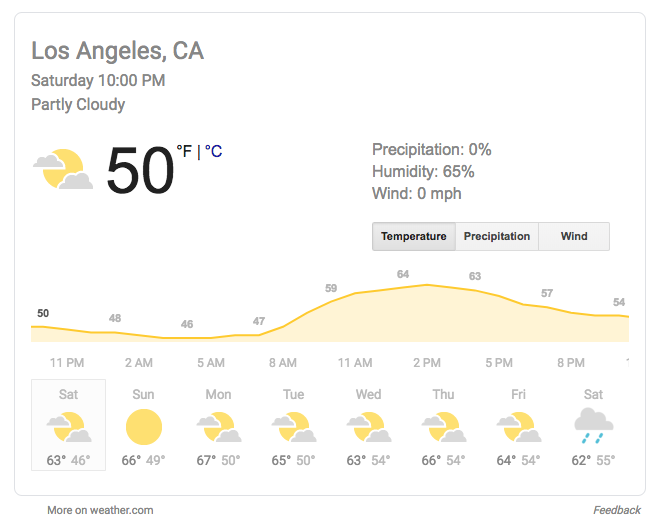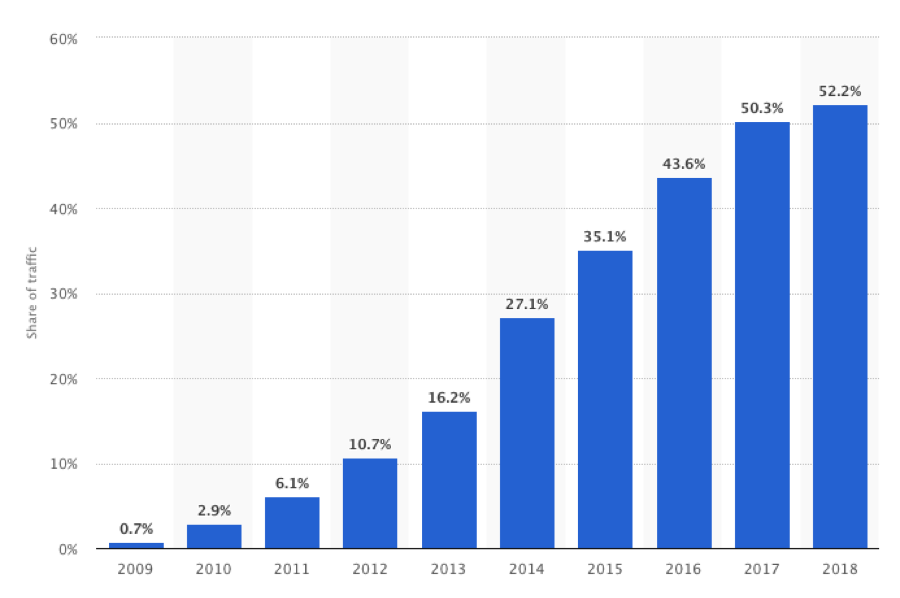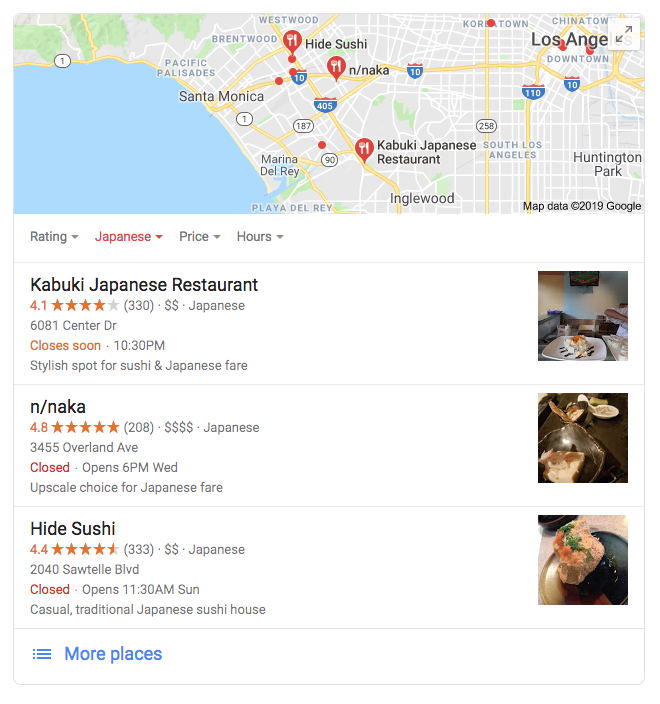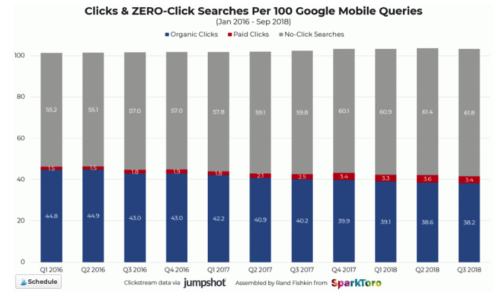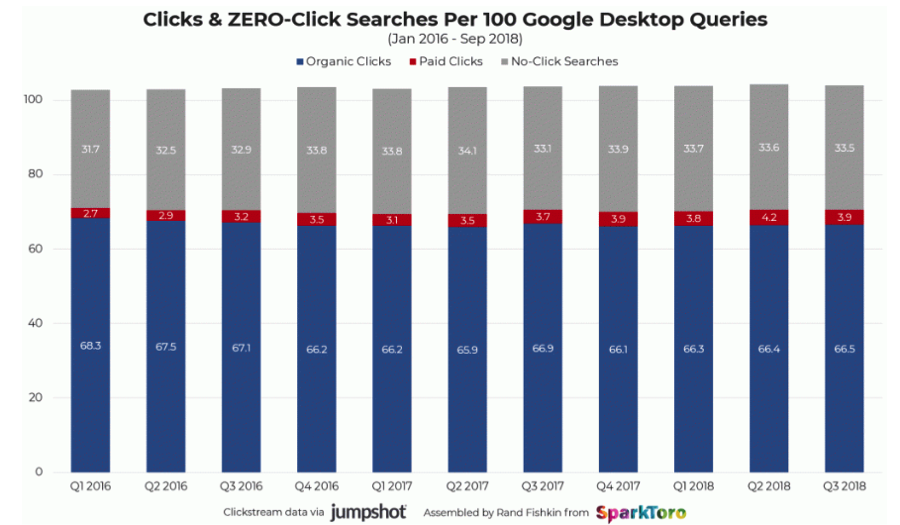With the increasing number of digital marketing channels available to local businesses, many business owners are asking if they should even have a website. My answer to that question is a resounding ‘yes’. In fact, a website is more important in 2019 than ever before.
In just a few short years, Google has taken chapter from Facebook’s playbook of changing the rules to their benefit. When Google had distant competitors such as Bing and Yahoo, they made decisions not only in their best interests, but also in the interest of content creators. Now that they have won the organic search game, they are changing the rules to benefit themselves and their users (as they should…) at the expense of content creators. This group also includes business and website owners as well.
Back to a better time…. For local business owners
Just a few short years ago, when you would do a local search in Google, it would primarily list the websites of highly ranked local businesses. They also had some of their own properties mixed in but this was a small number of properties.
Enter the same search query in 2019 and you get very different results. Search results display a much greater number of their own properties as well as those of their advertising partners. While the websites of local businesses are still shown, they make up a much smaller percentage of search results shown.
In this post, I will:
- Describe current trends
- Provide evidence of why a website is more important now than ever before, and
- Describe what SEO factors to focus on to improve your results?
Factors driving the need for a website
There are five key developments pertaining to Google that has increased the need for a local business to have a website. They include:
1. Zero-click mobile SERPs
Several years ago, Google consisted of just a single algorithm. As the company grew, new search algorithms were created that addressed the unique needs of mobile, local, and video searchers, amongst others.
Just what are zero-click mobile SERPs? They are search engine results shown on mobile devices that do not require a searcher to click through to another website. In the screenshot taken on a desktop computer, this zero-click SERP is pulling data from Weather.com.
Mobile search results are significant because 57% of all online traffic comes from smartphones and tablets.
Mobile search engine results pages (SERPs) are growing faster than desktop searches. In 2018, 52.2% of all Google searches were on mobile phones.
Percentage of all global web pages served to mobile phones from 2009 to 2018
As a result of Google’s focus on their own properties and those of their advertising partners, competition between content creators for the remaining placements is higher than ever.
Rand Fishkin, a leading SEO expert found that zero-click SERPs experienced a 20% increase in delivery of search engine results between 2016 and 2018. These are search engine results that give the searcher everything they are looking for within Google’s own interface.
Despite the increasing competition, local business owners need to be doing all they can to reach mobile searchers through Google. This primarily needs to be done through their websites.
2. Paid ads taking over local packs
When local packs first appeared in 2008, Google showed 10 local businesses in local SERPs. In 2010, the number decreased to 7 local businesses in the local pack.
In 2015, local packs in SERPs decreased yet again from 7 businesses to 3. However, there was a link at the bottom of local SERPs giving searchers an option to access additional businesses.
In recent years, Google has gradually been increasing the number of ads they display in local packs. In 2018, Dr. Peter J. Myers surveyed 11,000 local SERPs and found that 35% of competitive local packs feature ads.
3. Google controls everything…
When a user searches for your brand in Google, at the bottom of the page is the Google Knowledge Panel. It reads “People Also Searched For” and it displays other search queries made by users searching for your brand. This is functionality that has been in place for some time now.
A little more difficult to swallow is that Google is allowing advertisers such as Groupon to target the brand names of small businesses or food delivery services to do lead generation from local businesses.
Despite having almost $100 billion in the bank, Google still feels compelled to nickel and dime the small businesses that are the bedrock of our communities. Many small businesses work very hard to be profitable so every nickel and dime counts in a big way.
It is not only small businesses that benefit from Google. On the contrary, it is local business owners and content creators that provide Google with the material to index. They also provide the content that is used within Google’s own properties that are winning the race for page 1 search engine placements.
4. Lead generation by Google
Google’s Local Service Ads program positions the company as a paid lead generation service between local businesses and consumers. At last count, Google has taken over 23 business categories in 77 cities across the United States.
5. The new “homepage” for local business
Since Google is showing so many of their own properties and those of their advertising partners in first page search results, leading local SEO expert Mike Blumenthal came up with the term calling Google the new “homepage” for local business. The information that Google is showing within their own properties on first page search results include basic business information and driving directions. Searchers can also make a phone call, book something, ask a question, take a virtual tour and so on from within Google without ever going to an external website.
The effect of Google favoring their own properties over those of content creators in search results is that the number of local SERPs driving traffic to local websites is decreasing. As a result, competition between content creators for first page search listings is increasing. As you can imagine, many of these content creators are quite upset about Google’s focus on their own properties. However, as a ‘for-profit’ enterprise, Google has every right to maximize profitability. The questions that many are asking is just how much money does Google have to make.
The consequence of all five of these reasons is that more local businesses are questioning whether or not it is even worth it to have a website. Because of the fact that the information Google shows on their own properties comes from the websites of content creators, they absolutely should continue to invest in a website. Otherwise, they risk reducing the online footprint of their business, possibly impacting their business.
To survive and even thrive in this new competitive environment, content creators need to make some changes, including:
- Feed content to Google to use within their own properties.
- Feed content to Google through Google pages such as Google My Business
- Retain full control of where all your data is shown online.
Why your website should be the center of your digital strategy
Your website is one of the ways that content is fed to Google to display within their own properties. A recent study showed a strong correlation between top ranked websites and the information shown in zero-click search results on Google websites. Therefore, the best way to increases your chances of being included in zero-click search results is to have the strongest possible website.
While zero-click search results are taking a larger chunk of the search market, organic SERPs are still a substantial source of traffic for many websites. While mobile search results are showing many more zero-click SERPs, this is not the case with desktop SERPs.
While only 38.2% of 100 mobile searches are organic, 66.5% of desktop searches are organic. While mobile searches are growing much faster than desktop searches, desktop searches are still almost half of all searches on Google.
A second reason why a website is important for your business is because it is one of the types of media that you fully control, provided you pay your website hosting bills. Google and the social media platforms such as Facebook pretty much do as they please often keeping content creators in a state of uncertainty.
At any moment, Facebook, Google, or any of the social media platforms can remove your content or modify their search algorithms without warning. Even for those content creators and local businesses who are prepared, such changes can have a significant impact.
As an example, in the early years, Facebook presented themselves as the platform that could get your content in front of the largest audiences. Pretty soon, every business was trying to get you to follow them on Facebook, promoting not only your Facebook channel but also Facebook itself. Many marketers used their Facebook pages as the center of their digital marketing campaigns and just as many, spoke of doing away with their websites and just concentrate on social media.
Then what happened? After awhile, Facebook did away with organic reach and made everything paid promotion. For those content creators who based their campaigns from their social media properties, they saw fewer people seeing and sharing their content. Google seems to be taking a similar reach with regard to their organic search engine.
A way around increasing competition and declining reach
As with social media, there are ways around increasing competition and declining reach. The most obvious thing to do it to add an email newsletter to your website and go about building your list of email subscribers.
While email marketing is one of the oldest digital marketing channels, it is also one of the most effective. It often comes up time and time again as the marketing channel having one of the highest returns on investment (ROI).
When setting up your email newsletter and building your list, it is very important that you base your list building activities from your website. Highly qualified email lists can be very valuable and you need to ensure that your lists cannot be changed or deleted by other parties, in this case platform providers. The only digital marketing channel you can fully control is your website. This is of course as long as you continue to pay for your hosting and keep your domain name active.
How do build your email list?
Now that we have established why you need a website and how to you can counteract Google’s focus on their own properties, how do you go about building your newsletter subscriber list?
To start, you can make it make it easy to subscribe to your newsletter on your website. One of the most effective ways is with a pop-up that asks people to subscribe to your newsletter in response to a given condition. You can define the condition but it is often in response to a user on your website after a certain amount of time, navigating through your website, or upon leaving your website.
If you have a WordPress website, there are several plugins, both free and paid that can add this capability to your website. While they can be annoying to some users, they work. One case study reported a 30% increase in newsletter signups using these popups.
The second thing you can do is create great content. How do you find what kind of content to create? You research what your competitors are doing, you do online research, you ask your clients what problem are they trying to solve with your product or service? What information are they looking for pertaining to your industry?
With this information, you create content that addresses the issues identified in your research. This content can be in the form of a blog post or video but since we are talking about a newsletter, written content might be best.
Instead of creating your own content, you can link to other people’s content. If you go this route, make sure that you attribute the content to its creators. They spent time and resources to create the content, they deserve to benefit from their work.
The next thing is to create your content regularly. Releasing your newsletter once or twice a month is sufficient for most marketing and readers. This is of course going to depend upon the product or service you are offering and what your subscribers expect.
When you release your newsletter, make sure that it can be integrated into your social media profiles. In other words, it is very easy for your reader to share your content through their social media network. Additionally, your newsletter should be distributed through your social media channels.
There is a great deal more that can be added to this conversation. I will be exploring this in future blog posts.
What are some tips to surviving Google’s no-SERP era?
In addition to building out your email newsletter list, there are other things you can do to survive Google’s no-SERP era. Some tips provided by expert SEO Rand Fishkin, include:
Control what appears for your Brand: Reputation management has long been a tool in an SEO’s toolbox, it is only going to increase in importance as Google shows more and more results around our brand searches. By this, I mean those of our competitors.
If Google biases their services, create content for those services: The sites that Google is favoring includes YouTube, Google News, Google Maps and so forth. Create and optimize content for those sites that Google is prioritizing. Claim your Google Business, Panels and so on. This is where we will have to do our jobs in the near future.
If you are using Featured Snippets, entice the clicks: Google is very sophisticated. We are going to have to know what Google prefers, when and where. In other words, we are going to have to do our homework. In one example, Rand showed a slide of ’20 regional American accents ranked’. Some accents rank better than others. We will need to know what accents are better than others.
If other sites can rank, but you can’t, use Barnacle SEO: Barnacle SEO is attaching your content to other sites that can rank better than yours. Most everyone of these sites is accessible through guest content, outreach and sponsored content.
Whether Google is going to go in Facebook’s direction and fully embrace paid search remains to be seen. However, if Google does, they risk hurting the credibility of their business as they will be prioritizing financial performance over search performance. Many Google users will start searching for options, opening the door to competitors. The truth is that this may not be such a bad thing.
In addition to placing emphasis on our own sites, we should be focusing on the following:
- Delivering content that is exactly what searchers are looking for.
- Local SEO
- Mobile SEO
- Keyword targeting
- Citations
- Schema
- Backlinks
Wrapping it all up
Recently, Google has made some decisions pertaining to organic search. They are increasingly favoring their own properties and those of their advertising partners in organic search result, primarily mobile search.
This is demonstrated in the increasing prevalence of:
- Zero-SERP mobile search results
- Paid ads taking over local ads
- More lead generation
- Google’s home page for local business
The result for local businesses is increasing competition for coveted first page listings. The best way for content creators to respond is to focus on their websites, specifically focus on building out their email newsletters.
There are other things that they can do, such as:
- Delivering content that is exactly what searchers are looking for.
- Local SEO
- Mobile SEO
- Keyword targeting
- Citations
- Schema
- Backlinks
The competition will only be increasing. The Internet is too important for most content creators to ignore. The best thing that they can do is focus on their website and their customers.
Hopefully, I have made the case for why your business needs a website in 2019. Let me know your comments and feedback in the comments below.


